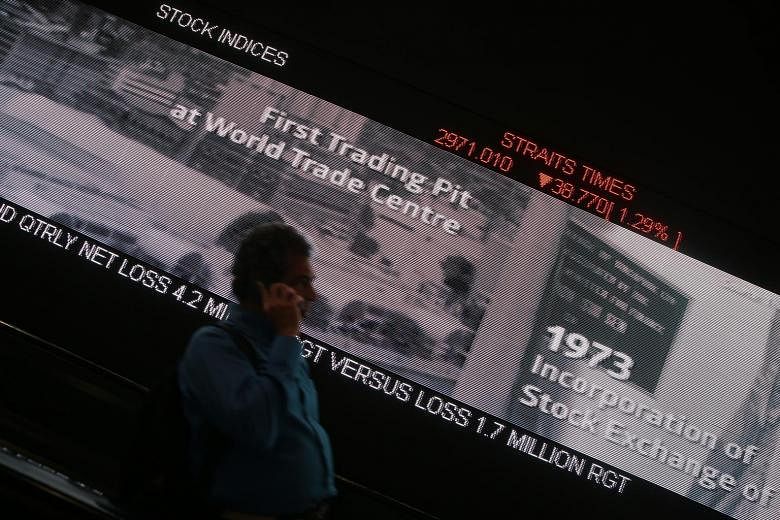Stock indexes used to be the preserve of academics and newspapers, worked out with pen and paper, to give investors a feel of where the market was headed.
No longer. Through the growth of huge wagers on derivatives trading and passive index investing, in which funds merely follow an index, trillions of dollars now track widely-watched indexes such as Wall Street's S&P 500 and Hong Kong's Hang Seng.
Given the huge sums involved, any change to the composition of a widely-followed index will have a significant impact on the counters involved.
For instance, in the latest revamp of the widely-watched Straits Times Index (STI), which takes effect today, the two giant Hong Kong-based conglomerates - Jardine Matheson (JMH) and Jardine Strategic (JSH) - as well as commodities firm Olam International exit the index.
These changes were prompted by new rules that require shares on the STI to have a reasonably high level of turnover or liquidity.
On Sept 4 - the first trading day following the announcement - JMH lost a hefty US$1.60, or 3.19 per cent, to US$48.50, while JSH tumbled 73 US cents, or 2.57 per cent, to US$27.72 and Olam shed five cents, or 2.46 per cent, to $1.98.
Even stocks linked to JMH and JSH suffered collateral damage. In the stampede out of the two counters, Jardine Cycle & Carriage was beaten down initially by as much as 62 cents, or 2.1 per cent, to an intra-day low of $28.88. It then closed almost unchanged at $29.49 as traders belatedly realised that it was unaffected by the STI changes.
It was a completely different picture for the three counters which become part of the STI from today. For UOL Group, SATS and Yangzijiang, joining the elite index of 30 stocks was nothing short of a boon.
In the two weeks since the announcement, SATS has jumped 8.8 per cent,Yangzijiang has surged 12.2 per cent while UOL has put on a more modest 0.6 per cent. The gains come despite the STI (with the three outgoing counters still in place) staying almost flat over the same period.
The reason stocks affected by a revamp are hit with price swings is the growth of benchmarking - active fund managers comparing their performance with an index.
As many fund managers have been unable to beat the index their performance is measured against, the next best thing they do is to try to model their portfolios as closely as possible on the index.
Thus, each time an index changes its composition, the inevitable rebalancing that takes place can cause market volatility as fund managers sell off the counters which have been dropped and load up on those nominated to replace them.
The dropping of the two Jardine counters also puts to rest repeated criticism over the years that since they are more thinly traded than other STI component stocks, there is a propensity to manipulate their share prices to influence the STI's closing value.
But dumping them also ends the association they enjoyed with the STI for much of the past two decades since they decamped from Hong Kong where they had been Hang Seng constituent stocks.
For many indexes, the nationality of its component stocks is a problem. A retail investor may mistakenly believe that in tracking the STI, he is aligning himself with the performance of the local economy. But this is not the case, as some STI counters such as Thai Beverage and Noble Group are based overseas, while others such as Jardine C&C and Wilmar International get a large part of their revenues overseas.
However, with the changes, STI will have more local content since two of the new component stocks - SATS and UOL - are home-grown success stories. The latest makeover also reduces the number of STI component stocks quoted in US dollars from four to two - Hong Kong Land and Hutchison Port Holdings Trust.
Those factors aside, an important measure of the STI's success is whether it will be more widely used by international fund managers to develop new tracker funds and derivatives products such as structured warrants and futures contracts.
Currently, while the STI is the most widely-watched market indicator by retail investors here and displayed prominently in newspapers and on TV, it is another index - the MSCI Singapore - that holds sway among fund managers.
For example, the MSCI Singapore is the index that is used to trade the SiMSCI contract in the futures market which gives traders a lever to bet on which way the local bourse is headed.
But with the makeover, STI will share more similarities with MSCI Singapore. Two of its new component stocks - UOL and Yangzijiang - are also part of the MSCI Singapore. That will hopefully prompt fund managers to adopt the STI as their benchmark for creating new products.
For the index providers, the icing on the cake is, of course, the licensing fee which they would get if the STI is more widely used in financial instruments. The latest changes may just give STI the edge that it needs.


